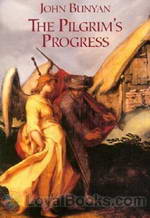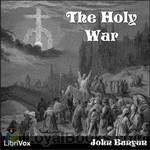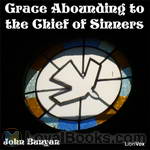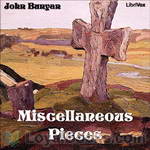|
Books Should Be Free Loyal Books Free Public Domain Audiobooks & eBook Downloads |
|
|
Books Should Be Free Loyal Books Free Public Domain Audiobooks & eBook Downloads |
|
Religion |
|---|
|
Book type:
Sort by:
View by:
|
By: Jewish Publication Society of America | |
|---|---|
 The Hallel (Psalms 113-118)
The Hallel (Psalms 113-118)
Hallel (Hebrew: הלל “Praise [God]“) is part of Judaism’s prayers, a verbatim recitation from Psalms 113-118, which is used for praise and thanksgiving that is recited by observant Jews on Jewish holidays. Summary from WikipediaRead by Délibáb, D.E. Wittkower, Jc Guan, Katie Gibboney, Leon Mire, and Scott Sherris | |
 Genesis (JPSA)
Genesis (JPSA)
The first book of the Pentateuch - Genesis. Presented according to weekly parshah.Praised are You, Adonai, Our G-d, ruler of the Universe, who has made us holy with commandments and commanded us to engage in the study of Torah. | |
 Exodus (JPSA)
Exodus (JPSA)
The second book of the Pentateuch - Exodus. Presented according to weekly parshah.Praised are You, Adonai, Our G-d, ruler of the Universe, who has made us holy with commandments and commanded us to engage in the study of Torah. (Introduction by Linette Geisel & traditional prayer. Parshat descriptions provided by Wikipedia) | |
 Torah (JPSA) 03: Leviticus
Torah (JPSA) 03: Leviticus
The third book of the Pentateuch - Leviticus. Presented according to weekly parshah. Praised are You, Adonai, Our G-d, ruler of the Universe, who has made us holy with commandments and commanded us to engage in the study of Torah. . - Summary by Linette Geisel. Parshat descriptions provided by Wikipedia | |
 Torah (JPSA) 04: Numbers
Torah (JPSA) 04: Numbers
According to Jewish tradition the 5 books of Moses are read and studied each year. In order to complete the study, the 5 books are separated into sections . The fourth book of the Pentateuch - Numbers. Presented according to weekly parshah. Praised are You, Adonai, Our G_d, ruler of the Universe, who has made us holy with commandments and commanded us to engage in the study of Torah. | |
 Torah (JPSA) 05: Deuteronomy
Torah (JPSA) 05: Deuteronomy
According to Jewish tradition the 5 books of Moses are read and studied each year. In order to complete the study, the 5 books are separated into sections . The last book of the Pentateuch - Deuteronomy is presented according to weekly parshah. Praised are You, Adonai, Our G_d, ruler of the Universe, who has made us holy with commandments and commanded us to engage in the study of Torah. Parshat descriptions provided by Wikipedia. | |
 Nevi'im (JPSA) 06: Joshua
Nevi'im (JPSA) 06: Joshua
The Book of Joshua is the first of the former prophets and the beginning of Nevi’im. The book of Joshua retells the conquest of Canaan and the division of the land among the Twelve Tribes. The conclusion includes Joshua’s address to the people and the witnessing of his death and burial. - Summary by Wikipedia and Linette Geisel | |
 Nevi’im (JPSA) 07: Judges
Nevi’im (JPSA) 07: Judges
The Book of Judges is the second of the former prophets within Nevi’im. The book of Judges covers the time between the conquest described in the Book of Joshua and the establishment of a kingdom in the Books of Samuel, during which Biblical judges served as temporary leaders. Judges, tell of the struggle of the people to possess the land. When the people are unfaithful, G_d delivers them into the hands of their enemies; once the people repent, mercy is given, a Judge delivers them from oppression until the cycle repeats... | |
By: Joanna H. (Joanna Hooe) Mathews (1849-1901) | |
|---|---|
 Uncle Rutherford's Nieces A Story for Girls
Uncle Rutherford's Nieces A Story for Girls
| |
By: Johann Adam Möhler (1796-1838) | |
|---|---|
 Symbolism
Symbolism
Johann Adam Möhler was professor theology at the Tübingen University where both Catholics and Protestants taught and studied. In 1832 he published Symbolism; a work that examined the doctrines of original sin, grace and free will as held by the different Christian confessions. It caused a storm of controversy in the Protestant nations of Europe. In it he turned the weapons furnished by Hegel, the “Protestant Aquinas”, against Protestantism. His method and style were supported by the use of facts, texts, and documents... | |
By: Johann Georg Bühler (1837-1898) | |
|---|---|
 On the Indian Sect of the Jainas
On the Indian Sect of the Jainas
| |
By: Johann Gerhard (1582-1637) | |
|---|---|
 Sacred Meditations
Sacred Meditations
Meditationes Sacrae, was first published in Latin in 1606 when Gerhard was only twenty-two years old. It consists of 51 brief meditations on various aspects of the Christian life. Nearly four hundred years after its first appearance, it remains the only work published by such a young author that has stood the test of time. Frequently reprinted in Latin, it has also been translated into most European languages as well as Greek and Arabic. While not a large book, it is impactive beyond its size. - Jonathan Lange | |
By: Johann Michael Reu (1869-1943) | |
|---|---|
 The Confutatio Pontificia
The Confutatio Pontificia
| |
By: Johannes Henricus Scholten (1811-1885) | |
|---|---|
 A Comparative View of Religions
A Comparative View of Religions
| |
By: John Beames | |
|---|---|
 Chaitanya and the Vaishnava Poets
Chaitanya and the Vaishnava Poets
| |
By: John Bosco (1815-1888) | |
|---|---|
 Life of St. Dominic Savio
Life of St. Dominic Savio
This it the most authentic biography of St. Dominic Savio, seeing as it is written by St. John Bosco, Savio's teacher. | |
By: John Bovee Dods (1795-1872) | |
|---|---|
 Twenty-Four Short Sermons On The Doctrine Of Universal Salvation
Twenty-Four Short Sermons On The Doctrine Of Universal Salvation
| |
By: John Boys (1571-1625) | |
|---|---|
 An Exposition of the Last Psalme
An Exposition of the Last Psalme
| |
By: John Brown (1830-1922) | |
|---|---|
 History of the English Bible
History of the English Bible
The celebration of the Tercentenary of the Authorized Version of the English Bible of 1611 has called into existence the little book here presented to the reader's notice. It is the brief repetition of a story beginning in 670 A.D. and reaching on for twelve hundred years to 1879. It takes us back to the Monastery of Whitby where Caedmon the monk paraphrased Scripture story in Saxon song, and brings us through the centuries to the Abbey of Westminster where a distinguished body of English scholars met in 1870 and commenced that Revision of the Scriptures which first saw the light in 1881. | |
By: John Brownlie | |
|---|---|
 Hymns of the Greek Church Translated with Introduction and Notes
Hymns of the Greek Church Translated with Introduction and Notes
| |
 Hymns from the East Being Centos and Suggestions from the Office Books of the Holy Eastern Church
Hymns from the East Being Centos and Suggestions from the Office Books of the Holy Eastern Church
| |
 Hymns of the Early Church
Hymns of the Early Church
This collection of hymns have been translated from the poetry to the Latin church, arranged in the order of the Christian year. "This volume is intended for hours of devotion, and the vast storehouse of sacred poetry of the Latin Church has been put under tribute to supply the material," writes the author, Reverend John Brownlie, in the preface. The collection includes hymns for Christmas, Easter, All Saints' Day, Advent, and more. | |
By: John Bunyan (1628-1688) | |
|---|---|
 The Pilgrim's Progress
The Pilgrim's Progress
A journey that takes the hero, Christian, through the varied landscapes that constitute life and through the events that happen to human beings is the plot of The Pilgrim's Progress by John Bunyan. Readers who have read and loved Louisa May Alcott's Little Women would recall the many references to this 17th century work of religious fiction. The Pilgrim's Progress is based on several values based in the teachings of Christianity. The importance of using the Bible as a guiding principle in life, of traveling not just geographically but also spiritually, the emphasis on community living and of the companionship of fellow people and many other themes... | |
 The Holy War
The Holy War
The Holy War is perhaps John Bunyan’s second most popular work, after The Pilgrim’s Progress. It tells the story of afierce battle to take control of a city from its rightful ruler. | |
 Grace Abounding to the Chief of Sinners
Grace Abounding to the Chief of Sinners
Grace Abounding is the spiritual autobiography of John Bunyan, who also penned Pilgrim’s Progress, perhaps one of the most significant pieces of Christian literature, second only to the Bible. Grace Abounding follows Bunyan’s struggle to find true repentance and forgiveness, his battle with Satan’s temptations of unbelief, his comfort found in the Bible and his overarching victory gotten by the grace of God through Jesus Christ his Son. Readers familiar with Pilgrim’s Progress will recognize... | |
 Miscellaneous Pieces
Miscellaneous Pieces
John Bunyan (November 28, 1628 – August 31, 1688), a Christian writer and preacher, was born at Harrowden (one mile south-east of Bedford), in the Parish of Elstow, England. He wrote The Pilgrim’s Progress, arguably the most famous published Christian allegory. In the Church of England he is remembered with a Lesser Festival on 30 August. Bunyan became a popular preacher as well as a prolific author, though most of his works consist of expanded sermons. In theology he was a Puritan, but there was nothing gloomy about him. The portrait his friend Robert White drew, which has often been reproduced, shows the attractiveness of his true character. | |
 The Pilgrim's Progress from this world to that which is to come
The Pilgrim's Progress from this world to that which is to come
| |
 Works of John Bunyan
Works of John Bunyan
| |
 The Holy war, made by King Shaddai upon Diabolus
The Holy war, made by King Shaddai upon Diabolus
| |
 An Exhortation to Peace and Unity
An Exhortation to Peace and Unity
| |
 The Pharisee and Publican
The Pharisee and Publican
| |
 The Jerusalem Sinner Saved; or, Good News for the Vilest of Men
The Jerusalem Sinner Saved; or, Good News for the Vilest of Men
| |